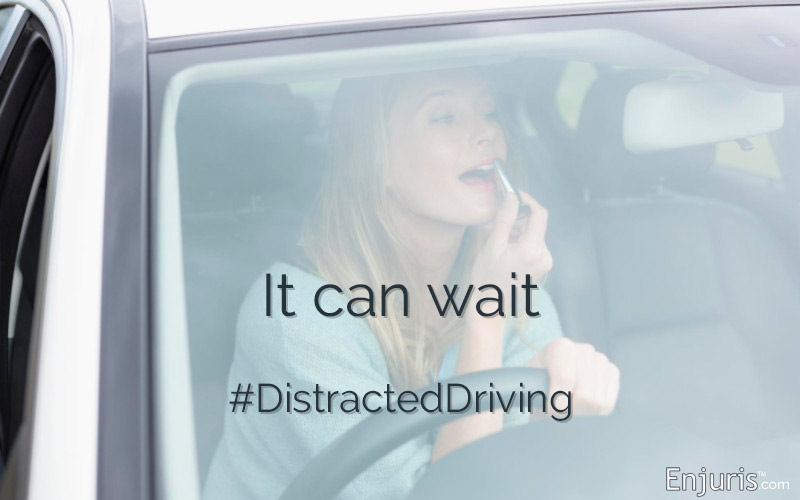‘An epidemic’ on the rise
Nearly 75% admit having done it... and 98% know that it’s dangerous.
So why does distracted driving still keep happening?
The Colorado Department of Transportation (CDOT) has determined that 22% of people have read a text message while driving a vehicle. Furthermore, 33% have talked on a phone while driving. Do you know how long it takes a focused driver going 55 miles per hour to come to a complete stop?
That's almost as long as a football field.
If there were an obstacle in front of your car – a median, a roadblock, a person, a child holding an ice cream cone – would you stop in time?
Would you bet on it?
Distracted driving statistics
There is currently “an epidemic” of distracted driving accidents in Colorado. At least 605 died because of it in 2016, which included an all-time high of 125 motorcyclists, 84 pedestrians and 16 bicyclists. This is an 11-percent increase from 2015, during which 547 people died on Colorado’s roads.
Officials have said that accidents are caused by human error 90% of the time – which is why they call them “crashes” instead of “accidents.”
Studies completed in Texas discovered that almost 10% of drivers are using their phone right at this moment. While driving. Additionally, 25% of car crashes involves a distracted driver. Transportation researcher Christine Yager attempted to see if voice-to-text software was safer than those who tried to text while stopped at a red light. This was what she discovered:
- The drivers’ responses were delayed regardless of which texting method was used.
- While drivers believe voice-to-text methods are safer, there are no safety advantages over manual texting.
- Drivers felt less safe with manual texting and safer with voice-to-text, even though their performance was approximately the same with both.
- In each case, drivers took twice as long to react as they did when they were not texting. (Remember the pedestrians and road hazards.)
- The amount of time drivers spent looking at the road was less when they were texting, no matter which type of texting they used.
Also, the Insurance Institute for Highway Safety has linked talking on a cellphone while driving to a fourfold increase in the chance of a crash.
Measures taken in Colorado against distracted driving
It’s probably a good thing that 84% of respondents supports statutory regulations that would prohibit using a cell phone while driving. A new bill has been introduced that would bump up punishment to $500 from $50 for first-time offenders caught driving while distracted.
As it stands now, drivers younger than 18 are not allowed to use phones while driving – even hands-free types. Exceptions include reporting emergencies, injuries, road hazards, or a person driving in an unsafe or reckless manner.
Drivers aren’t allowed to drive while texting, except during emergencies. A police officer only has to see them texting in order to pull them over because this is a “primary” law in Colorado, as opposed to a state like Florida where it is a “secondary” offense – meaning that the driver has to be committing a more serious crime as well as texting.
Meanwhile, in Colorado there is no cell phone prohibition for bus drivers – which seems a bit counterintuitive.
Fines for texting while driving are:
- First offense: $50 fine + $6 surcharge
- Second offense: $100 fine + $6 surcharge
Distracted driving is generally defined as the following:
- Eating
- Adjusting radio or music
- Checking email
- Grooming (brushing hair, putting on makeup, etc.)
- Posting to social media
- Reading
- Using a GPS
- Watching a video
Anything that takes your hands off the wheel and your eyes off the road is distracted driving.
What if I get hit by a distracted driver?
“It may seem like a harmless glance at your phone, but a AAA study indicates that the cognitive distraction from using your phone can last as long as 27 seconds after finishing a distraction task – incredibly too long while driving,” said Darrell Lingk, director of the CDOT’s Office of Transportation Safety.
People have become desensitized to the dangers associated with driving. We respect other vehicles, but cars are every day and common. Even though cars are gigantic metal monsters that can turn on you in an instant, drivers feel in control – enough to eat, groom or even read while behind the wheel.
Perhaps it has something to do with today’s culture and this “FOMO,” or “fear of missing out” – nobody wants to be the last one to know what’s happening. Everyone has to know everything going at every minute of the day. Others think their bosses will get upset if they aren’t immediately available. Many individuals are anxious if they don’t answer a text or call right away. For some, it’s even a dopamine release if the message is pleasant.
But what is the result? Car crashes. Injuries. Sometimes even death. This can mean teenagers – teenagers who were just texting, something so small and inconsequential – being responsible for the death of someone else, and they will have to carry that burden for the rest of their lives.
Distracted driving can cause a variety of different injuries:
- Whiplash
- Fractures
- Extensive bruising
- Spinal injuries
- Severe head trauma/brain injuries
- Amputations
- And more.
If you get hit by a distracted driver, don’t panic. First make sure that everyone is physically sound. Then:
- Call the authorities: Unless there was no damage, call the police. Their account will become the official record, and your insurance company will need that for their files. Move your cars to the side of the road to maintain the flow of traffic.
- Exchange information: Don’t say more than your name and insurance information to the other driver, because what you say will be used against you. Make sure to get his or her name, contact information, insurance information, license plate, car make and model, and driver’s license number.
- Get witness information: This is crucial, because witnesses are hard to track down.
- Photograph the scene and injuries: Injuries heal fast. Use your phone and take pictures of the cars, license plates, bruises, cuts and anything relevant.
- Receive medical attention: Make sure to see your doctor and document your injuries. It might take a few days for your damages to manifest, and by then your insurance company won’t connect it to the accident.
- Contact your insurance company: Start this process as soon as possible and keep all your documents in one place. It helps to use a post-accident journal and expense worksheet.
- Talk to an attorney: Even if you’re not sure about a lawsuit, a lawyer can help you decide how to proceed.
Either way, it makes most sense to speak to Colorado attorneys who have dealt with these matters before. Try the Enjuris law firm directory in Colorado, to find an attorney who is knowledgeable in both traffic statutes and motor vehicle law!
See our guide Choosing a personal injury attorney.


